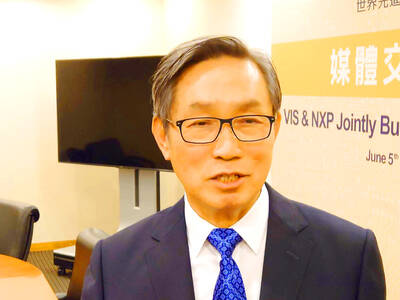The Ministry of Economic Affairs yesterday announced the establishment of a special zone for solar power developers at the Changhua Coastal Industrial Park (彰濱工業區), as part of the government’s plan to promote renewable energy.
With an installed power capacity of 320 megawatts, the 347-hectare site would be the nation’s largest solar power station, generating up to 436 million kilowatt-hours (kWh) on an annual basis.
The zone would help reduce carbon dioxide emissions by 230,000 tonnes per year, the ministry said in a statement.
The solar power facility has received nearly NT$16.3 billion (US$534.15 million) in total investment from Taiwanese firms, it said.
Three local companies — Chenya Energy Co (辰亞), Yeheng Energy (曄恆能源) and a major subsidiary of Taiwan Solar Energy Corp (TSEC, 元晶太陽能) — were awarded the right to build the special zone, it said.
The project is part of the government’s two-year plan to boost the nation’s solar capacity to 1.52 gigawatts, the ministry said.
Speaking at the launch ceremony, Deputy Minister of Economic Affairs Tseng Wen-sheng (曾文生) said the solar site featuring floating solar power plants would become a new landmark in Changhua County.
Tseng urged the central and local government to work together to complete the power plant as soon as possible.
The special zone could help ease the nation’s power shortage during the peak season of electricity consumption, Chinese-language media quoted TSEC chairman Ellick Liao (廖國榮) as saying in Changhua.
The project could also improve power self-sufficiency in the nation, Liao said, adding that Taiwan is an energy-dependent nation that imports nearly most of its fuel.
Changhua, widely seen as the nation’s emerging green hub, has also attracted offshore wind farm investments in recent years.

STEEP DECLINE: Yesterday’s drop was the third-steepest in its history, the steepest being Monday’s drop in the wake of the tariff announcement on Wednesday last week Taiwanese stocks continued their heavy sell-off yesterday, as concerns over US tariffs and unwinding of leveraged bets weighed on the market. The benchmark TAIEX plunged 1,068.19 points, or 5.79 percent, to 17,391.76, notching the biggest drop among Asian peers as it hit a 15-month low. The decline came even after the government on late Tuesday authorized the NT$500 billion (US$15.2 billion) National Stabilization Fund (國安基金) to step in to buoy the market amid investors’ worries over tariffs imposed by US President Donald Trump. Yesterday’s decline was the third-steepest in its history, trailing only the declines of 2,065.87 points on Monday and

TAKING STOCK: A Taiwanese cookware firm in Vietnam urged customers to assess inventory or place orders early so shipments can reach the US while tariffs are paused Taiwanese businesses in Vietnam are exploring alternatives after the White House imposed a 46 percent import duty on Vietnamese goods, following US President Donald Trump’s announcement of “reciprocal” tariffs on the US’ trading partners. Lo Shih-liang (羅世良), chairman of Brico Industry Co (裕茂工業), a Taiwanese company that manufactures cast iron cookware and stove components in Vietnam, said that more than 40 percent of his business was tied to the US market, describing the constant US policy shifts as an emotional roller coaster. “I work during the day and stay up all night watching the news. I’ve been following US news until 3am

Six years ago, LVMH’s billionaire CEO Bernard Arnault and US President Donald Trump cut the blue ribbon on a factory in rural Texas that would make designer handbags for Louis Vuitton, one of the world’s best-known luxury brands. However, since the high-profile opening, the factory has faced a host of problems limiting production, 11 former Louis Vuitton employees said. The site has consistently ranked among the worst-performing for Louis Vuitton globally, “significantly” underperforming other facilities, said three former Louis Vuitton workers and a senior industry source, who cited internal rankings shared with staff. The plant’s problems — which have not

TARIFF CONCERNS: The chipmaker cited global uncertainty from US tariffs and a weakening economic outlook, but said its Singapore expansion remains on track Vanguard International Semiconductor Corp (世界先進), a foundry service provider specializing in producing power management and display driver chips, yesterday withdrew its full-year revenue projection of moderate growth for this year, as escalating US tariff tensions raised uncertainty and concern about a potential economic recession. The Hsinchu-based chipmaker in February said revenues this year would grow mildly from last year based on improving supply chain inventory levels and market demand. At the time, it also anticipated gradual quarter revenue growth. However, the US’ sweeping tariff policy has upended the industry’s supply chains and weakened economic prospects for the world economy, it said. “Now